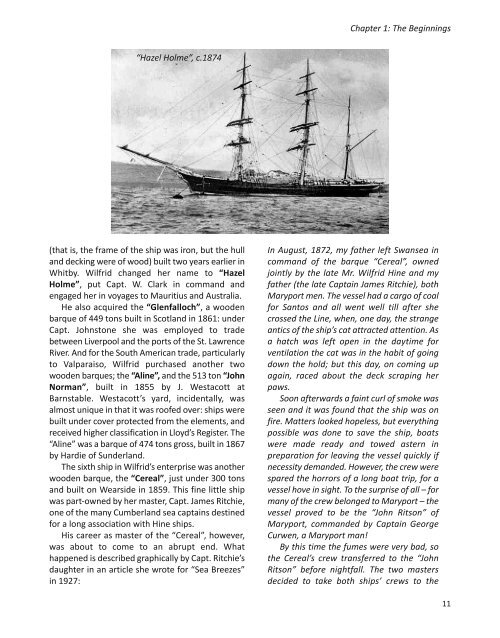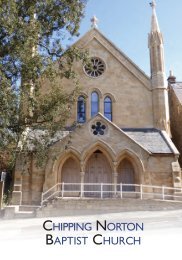A Cumberland Endeavour Sample
The story of Hine Brothers of Maryport, a shipping company founded and run by Wilfrid and Alfred Hine in the la er half of the nineteenth century. This book links the milestones in the company’s development to the important events in the lives of the brothers and their wider family; to the ships and the exploits of their captains and crews; and to Maryport itself, through the Victorian era un l just before the Great War.
The story of Hine Brothers of Maryport, a shipping company founded and run by Wilfrid and Alfred Hine in the la er half of the nineteenth century. This book links the milestones in the company’s development to the important events in the lives of the brothers and their wider family; to the ships and the exploits of their captains and crews; and to Maryport itself, through the Victorian era un l just before the Great War.
You also want an ePaper? Increase the reach of your titles
YUMPU automatically turns print PDFs into web optimized ePapers that Google loves.
Chapter 1: The Beginnings<br />
“Hazel Holme”, c.1874<br />
(that is, the frame of the ship was iron, but the hull<br />
and decking were of wood) built two years earlier in<br />
Whitby. Wilfrid changed her name to “Hazel<br />
Holme”, put Capt. W. Clark in command and<br />
engaged her in voyages to Mauritius and Australia.<br />
He also acquired the “Glenfalloch”, a wooden<br />
barque of 449 tons built in Scotland in 1861: under<br />
Capt. Johnstone she was employed to trade<br />
between Liverpool and the ports of the St. Lawrence<br />
River. And for the South American trade, particularly<br />
to Valparaiso, Wilfrid purchased another two<br />
wooden barques; the “Aline”, and the 513 ton “John<br />
Norman”, built in 1855 by J. Westacott at<br />
Barnstable. Westacott’s yard, incidentally, was<br />
almost unique in that it was roofed over: ships were<br />
built under cover protected from the elements, and<br />
received higher classification in Lloyd’s Register. The<br />
“Aline” was a barque of 474 tons gross, built in 1867<br />
by Hardie of Sunderland.<br />
The sixth ship in Wilfrid’s enterprise was another<br />
wooden barque, the “Cereal”, just under 300 tons<br />
and built on Wearside in 1859. This fine little ship<br />
was part-owned by her master, Capt. James Ritchie,<br />
one of the many <strong>Cumberland</strong> sea captains destined<br />
for a long association with Hine ships.<br />
His career as master of the “Cereal”, however,<br />
was about to come to an abrupt end. What<br />
happened is described graphically by Capt. Ritchie’s<br />
daughter in an article she wrote for “Sea Breezes”<br />
in 1927:<br />
In August, 1872, my father left Swansea in<br />
command of the barque “Cereal”, owned<br />
jointly by the late Mr. Wilfrid Hine and my<br />
father (the late Captain James Ritchie), both<br />
Maryport men. The vessel had a cargo of coal<br />
for Santos and all went well till after she<br />
crossed the Line, when, one day, the strange<br />
antics of the ship’s cat attracted attention. As<br />
a hatch was left open in the daytime for<br />
ventilation the cat was in the habit of going<br />
down the hold; but this day, on coming up<br />
again, raced about the deck scraping her<br />
paws.<br />
Soon afterwards a faint curl of smoke was<br />
seen and it was found that the ship was on<br />
fire. Matters looked hopeless, but everything<br />
possible was done to save the ship, boats<br />
were made ready and towed astern in<br />
preparation for leaving the vessel quickly if<br />
necessity demanded. However, the crew were<br />
spared the horrors of a long boat trip, for a<br />
vessel hove in sight. To the surprise of all – for<br />
many of the crew belonged to Maryport – the<br />
vessel proved to be the “John Ritson” of<br />
Maryport, commanded by Captain George<br />
Curwen, a Maryport man!<br />
By this time the fumes were very bad, so<br />
the Cereal’s crew transferred to the “John<br />
Ritson” before nightfall. The two masters<br />
decided to take both ships’ crews to the<br />
11



